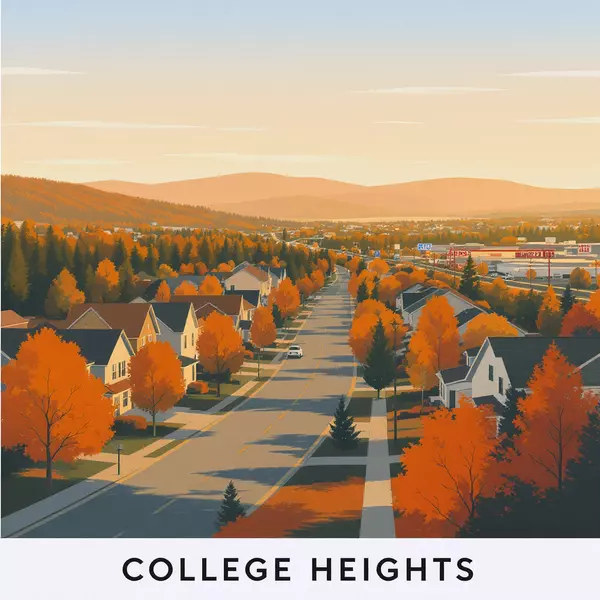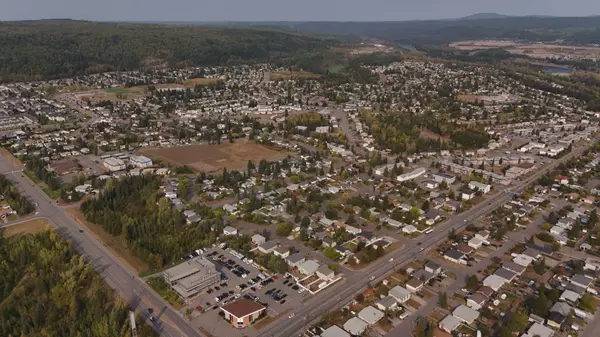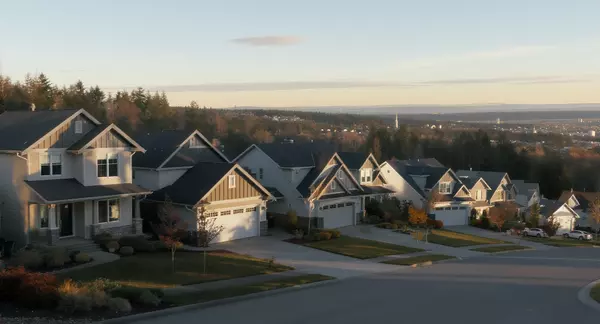College Heights, Prince George, BC Housing Market 2025-2026: 13 Must-Know Stats, Prices & Inventory

Quick answer: College Heights is one of Prince George’s most owner-occupied, family-oriented areas with higher-than-city-average incomes and a primarily single-family housing stock. Regionally, prices have been edging up modestly while inventory has tightened to balanced conditions; locally, new multi-family approvals in College Heights should expand options over the next few years. City of Prince George+2bcnreb.bc.ca+2
Intro (read this if you’re comparing neighbourhoods)
If you’re deciding between College Heights, Heritage, or the Bowl, here’s a plain-English market snapshot—drawn from current board stats, the City’s neighbourhood profile, and our on-the-ground notes—so you can budget realistically and buy with confidence. EMP Collective works with both buyers and sellers across Prince George and leads with proactive education (guides, videos, clear process) so you never feel rushed or sold to.
The College Heights Housing Situation in 13 Fast Facts
1. Who lives here (ownership & income): College Heights & University Heights tally ~10,090 residents, ~3,810 households, with ~85% owner-occupied and higher-than-city household incomes. Translation: stable, family-centric demand.
Deep Dive
College Heights (including University Heights) is a large, family-oriented pocket of Prince George with roughly 13,000 residents across just over 5,000 households and an average household size of about 2.7—bigger than the city overall. It is overwhelmingly owner-occupied (about 87% owners to 13% renters), which shows up in day-to-day stability: front-yard soccer nets, after-school traffic to parks, and long stretches of the same neighbours year after year. The housing stock skews decisively suburban—roughly four out of five dwellings are single-detached homes, with a smaller share of semis/rowhomes and low-rise apartments—so streets feel wide, lots are generous, and many properties offer extras like fenced yards, garages, and occasional suite potential.
Economically, College Heights trends more affluent than the city average. Households earn around the low-$130Ks on average versus roughly the high-$80Ks citywide, and typical monthly housing costs reflect that gap: owners sit in the mid-$1,500s and renters in the low-$1,200s. The age mix tilts “family-first,” with a larger-than-average share of kids and teens, plus a substantial cohort of 35–64—exactly the groups that drive demand for detached homes near schools and parks. Put simply, higher incomes, higher ownership, larger households, and a detached-heavy streetscape combine to create a stable, move-up neighbourhood dynamic that tends to command a price premium within Prince George.
2. Monthly housing costs (owner vs renter): Owners spend roughly $1,501/mo on housing; renters around $1,352/mo (city profile panel), which helps explain the area’s strong ownership base.
Deep Dive
Monthly housing costs (owner vs. renter) In College Heights, typical owner carrying costs average about $1,570 per month, while renters average roughly $1,210 per month, a spread that helps explain the neighbourhood’s very high owner-occupancy and “stay-put” feel. These figures reflect College Heights’ suburban profile—lots of detached homes, garages, and larger lots—which often translate into mortgages, property taxes, and utilities that are manageable for the area’s higher-than-city household incomes. Many owners further reduce net out-of-pocket costs by using suite-ready basements as “mortgage helpers,” a common feature promoted in local listings. For households that prefer to rent, there’s an active (but smaller) pool of purpose-built apartments; newer complexes in College Heights command premium rents—recent examples show starting prices around $1,648 for 1-bed, $1,878 for 2-bed, and $2,228 for 3-bed—trading higher monthly payments for modern finishes, in-suite laundry, and pet-friendly amenities.
3. What gets built (and why it feels suburban): Single-detached homes dominate the stock, many on generous lots, with frequent extras like fenced yards, RV parking, and basement suite potential for “mortgage helper” income.
Deep Dive
College Heights reads like classic suburban Prince George because of what was built and when it was built. The neighbourhood’s backbone is the single-detached home, which makes up the vast majority of dwellings (~79%), with smaller shares of semis/rowhouses (~11%) and apartments (~9%)—a mix that naturally produces wider lots, quieter crescents, and family-first floor plans. This physical fabric reflects a long development arc: substantial building began in the 1950s–1960s, so you’ll find mid-century homes alongside steady waves of newer subdivisions that keep the streetscape looking fresh. Inside the typical house, expect 3–5+ bedrooms, plus the northern-practical extras that listings constantly highlight—fully fenced yards, RV parking, and basement “mortgage-helper” suites—all of which reinforce an owner-occupied, family-centric feel. At the same time, the stock has diversified: beyond detached homes, you’ll see half-duplexes, row houses, and townhome complexes (e.g., Northridge Green, St. Anne Estates), gated communities like Cobblestone, and purpose-built apartments such as O’Grady Heights—an evolution from a purely single-family suburb to a more multifaceted community. That shift isn’t random; it’s driven by market demand and municipal planning to add density in well-serviced areas—one reason College Heights still feels calm and residential while gradually offering more housing choice.
4. Regional price context (Sept 2025): Across the BC Northern Real Estate Board area, the average sale price in September was $441,465 (↑2.6% YoY). Useful for trend-spotting when you’re comparing PG sub-areas. bcnreb.bc.ca
Deep Dive
Across the BC Northern Real Estate Board area, prices have been edging up—not spiking, but steadily regaining ground. In September 2025 the average sale price was $441,465 (+2.6% YoY), and the year-to-date average sat at $445,910 (+4.5% YoY). Sales hit 368 units—the best September in four years—while new listings eased to 520 (−8.3% YoY). That combination pulled active listings down to 1,918 (−7.3% YoY) and trimmed months of inventory to 5.2 (from 6.6 a year earlier), a classically balanced setup that can feel slightly tighter in the most in-demand pockets. For local context in the City of Prince George through the end of September, 1,066 properties changed hands versus 1,004 a year earlier, and sub-areas showed distinct price bands—West PG median around $474K, East of the Bypass single-family ~$419.5K (avg), and The Hart single-family ~$585K (avg)—a reminder that neighbourhood choice (like College Heights) meaningfully shapes what you’ll actually pay. bcnreb.bc.ca+1
5. How tight is supply? End-of-September active listings: 1,918; months of inventory: 5.2—a balanced market that leans slightly toward sellers in the most in-demand pockets. bcnreb.bc.ca
Deep Dive
Supply across the BC Northern Real Estate Board area is balanced but tightening. As of September 2025, there were 1,918 active listings on the market and months of inventory (MOI) sat at 5.2, down from 6.6 a year earlier and below the long-run September average of 5.8—a clear sign conditions have firmed compared to last fall. New supply also eased, with 520 new listings in September (−8.3% year over year), and both active and new listings tracking below their 5- and 10-year September averages. In practical terms, an MOI near five falls into the classic “balanced” zone (roughly 4–6 months), where neither side has a huge advantage—but in sought-after sub-areas like College Heights, desirable, well-priced homes can still draw quick attention because the regional averages mask micro-market pressure. For buyers, that means more selection than in a true seller’s market but less room for delay; for sellers, accurate pricing and turnkey presentation remain decisive. bcnreb.bc.ca MoneySense
6. Sales momentum: September sales hit the best level in four years for the BCNREB region (↑17.6% YoY), signalling resilient demand even with higher rates. bcnreb.bc.ca
Deep Dive
Sales are trending sturdier across Northern BC, and Prince George is part of that lift. Seasonally adjusted, third-quarter 2025 sales in the BC Northern Real Estate Board area reached 1,049, which is 7.1% higher than Q3 2024 and only 1.4% below the 10-year average—evidence of a market that’s firmed up from spring while staying broadly balanced. The Board also pegs the sales-to-active-listings ratio near 20%, brushing the upper end of “balanced” territory. In the City of Prince George, year-to-date deals climbed to 1,066 by September 30 (up from 1,004 a year earlier), and the dollar value of September sales across the BCNREB region jumped ~20.6% year over year, a sign that both activity and mix supported stronger volumes. For College Heights specifically, this momentum tends to translate into quicker attention for well-priced, family-oriented listings—especially near top school catchments—without the runaway bidding patterns of a true seller’s market. bcnreb.bc.ca bcnreb.bc.ca
7. New multi-family is coming to College Heights: Council gave final approval for a 1.91-hectare multi-family development in College Heights (Ridgecrest), adding long-needed variety beyond SFDs. Prince George Citizen
Deep Dive
After a year of public process, the College Heights multi-family proposal on a 1.91-hectare (4.7-acre) portion of 8640 St. Lawrence Ave. and 2800 Vista Ridge Dr. cleared its final hurdles in late June 2025, when council gave unanimous approval to the needed OCP and zoning amendments—paving the way for higher-density homes in a neighbourhood historically dominated by single-detached stock. Earlier steps included a September 25, 2024 public hearing, where the proponent sought to rezone from RS2 to RM5 (high-density residential up to ~125 dwellings/ha); council postponed a decision then to obtain a fresh traffic impact study, which later informed the approvals that followed (third readings granted in December 2024, and final adoption in June 2025). For buyers and renters, this matters: over the next few years, expect more townhome and apartment options in College Heights, adding choice for first-time buyers, right-sizers, and investors—while also easing some pressure on detached listings in this family-oriented pocket. princegeorgecitizen.com+3princegeorge.ca+3pgdailynews.ca+3
8. Policy pathway (how we got here): The project advanced through late-2024 readings and returned to council before the 2025 approval—an indicator that the City is actively enabling more supply in this area. Prince George Citizen
Deep Dive
The College Heights project followed a textbook—and unusually transparent—policy arc that shows the City actively steering more housing into serviced neighbourhoods. First and second readings for the OCP and zoning amendments (Bylaws 9445 and 9446) were granted on July 22, 2024, setting up a land-use shift from Neighbourhood Residential → Neighbourhood Corridor and a site rezoning from RS2 (Single Residential) → RM5 (Multiple Residential) on 8640 St. Lawrence Ave. & 2800 Vista Ridge Dr. After the first public hearing on September 25, 2024, council postponed a decision pending an updated Traffic Impact Study, then scheduled a second public hearing for December 2, 2024, where the bylaws advanced to third reading. In mid-2025, council returned to give final reading/adoption (June 23, 2025) to the zoning amendment—effectively green-lighting higher-density homes on a 1.91-hectare portion of the site—while local coverage noted the votes were unanimous at the final stage. Practically, this pathway matters for buyers and investors because it marks a deliberate pivot: OCP re-designation enables multi-family in a historically single-family pocket, RM5 zoning permits high-density forms (with policy context indicating up to ~125 dwellings/ha), and the extra traffic work signals council’s intent to pair new supply with transportation mitigation—altogether, a clear “yes” to more housing choices in College Heights with conditions that manage growth. Prince George Daily News+8City of Prince George+8City of Prince George+8
9. Neighbourhood premium: Compared to most PG areas, College Heights typically commands a price premium thanks to reputation, schools, and amenities—expect quicker absorption on well-priced listings.
Deep Dive
College Heights consistently trades at a premium within Prince George because buyer demand meets a supply of bigger lots, family-friendly floor plans, and top-tier school catchments. On the numbers, the owned-home market here is “characterized by higher-than-average prices for Prince George, strong demand, and rapid sales”; in 2022, average list was $620,000 and average sale was $621,600 (100% of ask) with ~35 days on market, a clean signal of price strength and fast absorption that locals recognize when setting expectations. Price bands reinforce the premium: entry single-family options typically start around $380K–$500K, the mid-range runs $500K–$800K, and executive/newer homes in subdivisions like University Heights often clear $1M, with some listings reaching ~$1.6M. The “why” behind those numbers is structural: College Heights pairs exceptional school reputation—CHSS is noted as the best-ranked high school in Prince George and among the stronger performers provincially—with a dense network of daily conveniences, both of which draw and retain higher-income family buyers. The premium even shows up on the rental side: newer purpose-built apartments in College Heights rent 17%–28% above city averages, indicating a willingness to pay for location, amenities, and schools that spills over into ownership values. Add in the area’s very high homeownership (≈87%) and higher household incomes, and you get a stable, “sticky” buyer pool that keeps benchmark pricing resilient through market cycles.
10. Rental options exist (but fewer than owners): While predominantly owner-occupied, the area does include townhomes and purpose-built apartments (e.g., O’Grady Heights; Broadstreet’s College Heights Apartments), useful for renters or down-sizers wanting the location.
Deep Dive
Although College Heights is overwhelmingly owner-occupied (~87% owners / 13% renters), it does support a modern rental ecosystem anchored by purpose-built apartment buildings and a handful of townhouse/condo communities. The headline option is Broadstreet’s College Heights Apartments, where late-2025 starting rents were listed around $1,648 (1-bed), $1,878 (2-bed), and $2,228 (3-bed)—pricing that sits ~17%–28% above Prince George city averages and signals strong willingness to pay for the location, schools, and amenities. These newer buildings are typically pet-friendly and come with in-suite laundry, air conditioning, private balconies/patios, and secure keyless entry; some add community perks like dog-wash stations, dog runs, and gardens. Beyond Broadstreet, O’Grady Heights and other purpose-built complexes widen the options for right-sizers, UNBC/CNC-linked renters, and professionals who want College Heights without the maintenance of a detached home. On the attached side, row/townhome complexes (e.g., Northridge Green, St. Anne Estates) add medium-density stock that can function as owner-occupied or rental housing (strata-dependent), bridging apartment convenience with more of a single-family feel. Overall tenant feedback trends positive on cleanliness, maintenance, and management; winter notes often flag snow-removal quirks in guest parking—worth asking about during tours and in lease terms.
11. Mobility reality: Expect a car-forward lifestyle; transit exists but isn’t the main draw. Most day-to-day errands cluster along the Highway 16 commercial corridor.
Deep Dive
Day-to-day life in College Heights is decidedly car-first. An objective snapshot shows a Walk Score of 13/100, meaning very few errands can be done without driving; the common pattern is to drive to a commercial hub (plaza/big-box corridor) and then walk between stores. For non-drivers, BC Transit does serve the neighbourhood, but it’s best viewed as supplementary rather than primary: core routes include 16 (UNBC/College Heights)—typically every 30–60 minutes—plus 19 (UNBC/Westgate), 88 (Westgate), 89 (Hart), and 12 (Parkridge) linking to UNBC, CNC, Pine Centre, Downtown, and Westgate. Most residents still choose to drive because the road network and abundant parking make it easy, and a cross-town trip is often 20 minutes or less in normal conditions. As the area grows, traffic is the top community concern at public hearings; roads remain within design thresholds for now, but winter hills and added households can slow things down at peak times. Around the big-box corridor, expect heavier volumes—and locals note that occasional pulp-mill odours can drift through the Walmart area—another reason people prefer quick, targeted trips by car over walking long distances.
12. Schools (major magnet): College Heights Secondary is widely recognized as a top academic high school locally—one reason many families target this catchment.
Deep Dive
College Heights’ school ecosystem is a huge draw for families because it offers both quality and choice. At the secondary level, College Heights Secondary School (CHSS) anchors the neighbourhood’s reputation: it’s described as an academic leader in the region, ranked the top high school in Prince George and placed 63rd in B.C. by the Fraser Institute—signals that routinely influence where education-focused buyers choose to live. CHSS’s scale (about 1,000 students) supports a broad program mix—Honours English, AP English Literature, and a notably rich languages department (German, French, Japanese, Spanish)—plus an extracurricular slate that ranges from volleyball, rugby, basketball, hockey, and football to clubs, drama, a longstanding Japan exchange, and even a SALTS sailing/leadership trip on the B.C. coast. On the elementary side, parents can pick from several schools inside or adjacent to the catchment, including École College Heights Elementary (English + French Immersion), Southridge Elementary, Malaspina Elementary, and fringe options like Beaverly and Vanway; Polaris Montessori sits within College Heights and accepts students district-wide as a choice program, giving local families another pathway without leaving the neighbourhood.
The education story doesn’t stop at K–12. College Heights sits in close proximity to UNBC on Cranbrook Hill and has easy access to the College of New Caledonia (CNC), which attracts faculty, staff, and students seeking short commutes and stable rentals. That proximity feeds a local “education loop,” where strong K–12 options, post-secondary access, and family-friendly housing reinforce one another and help sustain the area’s price premium. Put simply, if school quality and convenience are near the top of your list, College Heights delivers an unusually complete package—and that’s a big reason well-presented listings here tend to move quickly.
13. Assessments & budgeting: 2025 assessments in North Central BC generally ranged from -5% to +10%, while Prince George’s overall residential values rose ~1.9%—helpful for tax and refinance planning. BC Assessment+1
Deep Dive
For 2025, BC Assessment shows Prince George’s overall residential values up about 1.9%, while North Central homeowners generally saw changes between −5% and +10%—a steady, “flat-to-modestly-up” picture that’s useful for tax planning and refinancing conversations. Remember, assessments reflect market value as of July 1, 2024 and are primarily a benchmarking tool; your property tax change depends on how your home’s assessment moved relative to the community average, not the raw % on your notice. If your place rose more than the local average, expect upward pressure on taxes; if it rose less (or fell), pressure eases. Practical to-dos: confirm details on bcassessment.ca, compare to similar nearby sales, and—if something looks off—note that formal complaints are due by January 31 each year (PARP). Also check homeowner grant rules and thresholds to optimize cash flow. All in, this year’s numbers support realistic budgeting (minor tax shifts for most) and refi/appraisal prep (use the new assessment as one data point alongside current sales and lender requirements). Prince George Citizen+6Prince George Citizen+6Yahoo Finance+6
What this means if you’re buying (or selling) in 2025
- Buyers: Balanced regional conditions + College Heights’ micro-premium = be pre-approved, know your ceiling, and move quickly on well-priced homes. Consider suite-ready layouts for payment flexibility.
- Sellers: Clean pricing and day-one presentation still win. Expect stronger traction near schools/parks and on updated family floor plans.
- Investors: Watch the Ridgecrest timeline; multi-family adds rental choice and comps. Pair that with our cash-flow models before writing.
FAQs
- Is College Heights a good place for families? Yes—high ownership, strong school catchments, and convenient amenities make it a perennial top pick. City of Prince George
- Are prices rising or falling? Regionally, average prices ticked up ~2.6% YoY in Sept 2025; College Heights typically sits at a premium versus city averages. bcnreb.bc.ca
- Will there be more housing choice? Yes—1.91 ha of new multi-family has City approval in College Heights. Prince George Citizen
- Is it walkable? You can walk trails and schools, but daily errands tend to be car-oriented.
Conclusion & next step
If you want a calm, amenity-rich, school-centric base with strong resale fundamentals, College Heights should be on your shortlist. Want a clearer path to “offer-ready”? Grab our buyer guide and we’ll map budget, neighbourhood fit, and on-market comps together—no pressure, just straight talk and a plan.
Categories
Recent Posts




